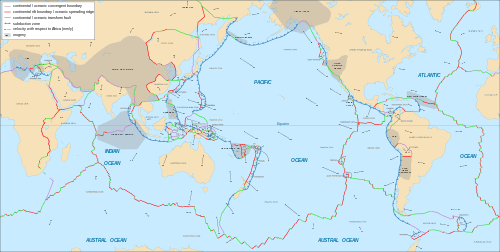Plate tectonics and the structure of the Earth's crust
To be followed in Topic:Plate tectonics.
See articles on w:Plate tectonics and planetary w:Crust (geology).

The theory of plate tectonics has been around for about 50 years, it can explain phenomena such as mid w:oceanic trenches, large-scale volcanic mountain ranges, and earthquakes. But w:mantle plumes, underwater mountain ranges, geysers etc are harder to explain. As we continue to gather knowledge we could one day get a full picture of how our earth functions and to predict disasters before they happen.
What is a Tectonic Plate
A tectonic plate is the crust of the planet that is divided by fault lines, all oceanic and continental rock is part of of a tectonic plate down too and including the upper mantle, this is the w:lithosphere. The center of a tectonic plate is an area of moderately stable crust without a high frequency of earthquakes, volcanoes and plate instability are associated with areas close too and including plate boundaries, though it can not be said that they do not occur within the center of the plate. The plate is made up of two categories of rock, that of continental rock and oceanic rock. See the articles for a description.
Plate boundary
Convergent boundary
A w:convergent boundary is a section of a plate that is moving towards and colliding with another plate. A good example is the w:Indian plate moving north into the w:Eurasian plate forming the w:Himalayas. There are three types of plate convergence, oceanic-oceanic convergence: where the colder denser plate sub-ducts under the other less dense plate (Pacific plate sub-ducting under the Australian plate north of New Zealand, but the Australian plate does sub-duct under the pacific plate in other areas), Oceanic-continental: where the oceanic plate sub-ducts under the continental plate (Nazca plate sub-ducting under the South American plate), and continental-continental convergence (Indian plate is moving north wile the Eurasian plate is moving south).
Divergent boundary
This is where two or more plates are separating and moving in different directions. At the center of the divide is a rift. A rift is an area of continent where one plate has started to divide in two. This then forms a rift valley which eventually forms a mid oceanic ridge where new plate is being formed. Each plate is usually going in opposite directions. As the oceanic rift is not continuous, but is fractured and there is a separation of transforming boundaries of many kilometers between the fractures[1]. These separated fractures are connected by w:transforming boundaries. So an up-well of w:magma might not take place at close trenches at the same time, causing the same plate to be moved independently at different divergent centers. Fractures caused by this displacement can continue for many kilometers, sometimes many hundreds into the plate.
Transforming boundary
These type of plates are moving past each other, they are the least numerous of the plate boundaries, but as in the San Andreas fault, can be quite devastating.
The role of convection
Major types of rock produced
There are various ways rocks are formed, the major ones are sedimentary and igneous with metamorphic being either of the two as precursors.
For Igneous rocks there are two main types, that classed as basaltic and granitic. The former occurs mainly on continental and the later is the predominant rock forming the ocean bedrock.
Minor types of rock produced
There are many minor types of rocks that make up the three categories of rock types by formation.
Readings
Sedimentary rocks
- http://earthds.info/pdfs/EDS_05.PDF Sedimentary rocks.
- http://danling.com/earthling/geo/Chapter%206%20Outline%20-%20Sedimentary%20Rocks.pdf
Igneous rock
- http://earthds.info/pdfs/EDS_04.pdf Igneous rocks
- http://msnucleus.org/membership/html/jh/earth/igneous/jhigneous.pdf Igneous rocks 2
Metamorphic rock
- http://earthds.info/pdfs/EDS_06.PDF Metamorphic rocks
Other rock types
Resources
- Perspectives on Ocean Science: Geology in Your Backyard by Dr. Neal Driscoll, youtube video 56:07 minutes long
- Sumatran plate boundry at Caltech
- Plate boundry processes- UTIG
- Geology AS 2: Rocks
External Links
- Google Map of The Topography of Plate Tectonics Zoom in close on the volcanoes, hydrothermal vents, surmounts, submarine fracture zones and mid-ocean ridges that comprise the plate edges.